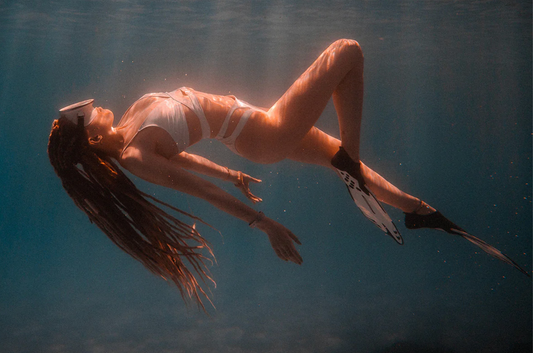How To Swim with Locs
As a loctician, I’ve had countless clients ask me the same question every summer: “How do I swim without damaging my locs?” Whether it’s chlorine from pools, salt from the ocean, or even lake water, your locs need protection before, during, and after a swim. Locs are not fragile, but they are highly absorbent — like natural sponges. This means they can soak up water, chemicals, and impurities, which can lead to dryness, discoloration, odor, or even mildew if not cared for properly.
If you love the water but want to keep your locs looking healthy and fresh, here’s exactly how I recommend swimming with them.
1. Pre-Swim Prep Is Everything
Before your locs ever touch the water, give them a fighting chance by prepping them. I advise clients to:
- Fully saturate your locs with clean water before entering the pool or ocean. This limits how much chlorine or saltwater your hair can absorb. Think of it as filling a sponge with clean water before it touches a colored liquid.
- Apply a light oil or leave-in conditioner to seal the cuticle. Natural oils like jojoba, almond, or argan create a protective barrier without weighing your locs down.
- Consider a swim cap — yes, even with locs. While a cap won’t keep your hair bone dry, a well-fitting silicone or stretch cap will minimize direct exposure. For longer or thicker locs, look for “extra-large swim caps” designed for braids and dreads.
2. During the Swim – Smart Handling
- Tie up your locs in a bun, ponytail, or braid to keep them from tangling or whipping around in the water. Loose locs are more prone to snagging and absorbing extra water.
- Avoid excessive underwater flips or dives if you’re trying to keep them as dry as possible. This might sound like a buzzkill, but it reduces the time your locs spend submerged.
- Stay mindful of water quality — chlorinated pools can dry locs, while ocean water’s salt can strip moisture. Natural bodies of water may contain bacteria or sediment that can cling to hair fibers.
3. Post-Swim: The Non-Negotiable Rinse
This is the step most people skip, but it’s the most important. Immediately after swimming:
- Rinse thoroughly with fresh water — don’t wait until you get home. The quicker you flush out chlorine, salt, or lake residue, the better.
- Shampoo if needed — If you’ve been in heavy chlorine or murky water, use a residue-free shampoo to cleanse your locs without leaving buildup. For frequent swimmers, I recommend a gentle clarifying wash once a week to prevent discoloration and dryness.
- Condition strategically — Apply a lightweight conditioner or aloe-based spray to restore softness. Avoid heavy creams that can trap moisture inside locs and cause odor.
4. Drying – The Mildew Prevention Step
Locs hold water deep within their core. If they’re not dried properly after swimming, you risk mildew (yes, it happens).
- Squeeze, don’t wring — Gently press out water with a microfiber towel or an old cotton T-shirt.
- Air dry in the sun when possible — Sunlight is a natural disinfectant and helps speed up drying.
- Use a hooded dryer or blow dryer on low heat if you have thicker or mature locs that take hours to dry naturally.
5. Extra Tips for Frequent Swimmers
- Invest in a swim spray made for locs — these often contain apple cider vinegar or citrus extracts to neutralize chlorine and bacteria.
- If your locs are light-colored or dyed, wear a cap every time — chlorine and saltwater will fade color quickly.
- Schedule regular deep cleans every 4–6 weeks to remove hidden buildup from repeated swims.
Final Word from Your Loctician
Swimming with locs is absolutely possible without sacrificing their health or beauty — you just need a strategy. I tell clients to think of it like skincare: you wouldn’t spend a day in the sun without sunscreen and cleansing after, so treat your locs with the same protective care. With a proper pre- and post-swim routine, you can enjoy every pool party, beach day, or vacation while keeping your crown in pristine condition.


